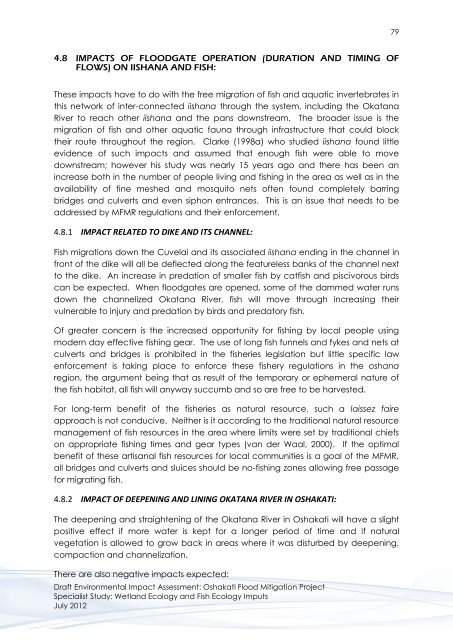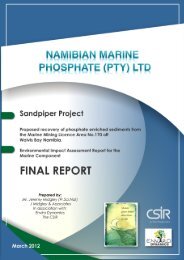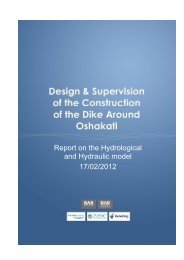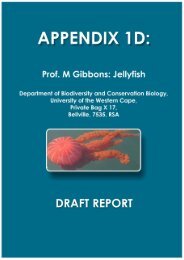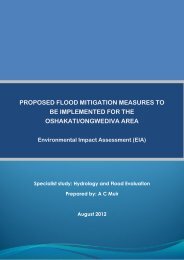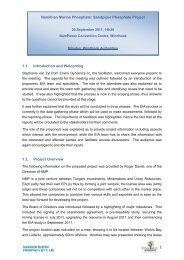Wetland & Fish Ecology - Enviro Dynamics Namibia
Wetland & Fish Ecology - Enviro Dynamics Namibia
Wetland & Fish Ecology - Enviro Dynamics Namibia
Create successful ePaper yourself
Turn your PDF publications into a flip-book with our unique Google optimized e-Paper software.
79<br />
4.8 IMPACTS OF FLOODGATE OPERATION (DURATION AND TIMING OF<br />
FLOWS) ON IISHANA AND FISH:<br />
These impacts have to do with the free migration of fish and aquatic invertebrates in<br />
this network of inter-connected iishana through the system, including the Okatana<br />
River to reach other iishana and the pans downstream. The broader issue is the<br />
migration of fish and other aquatic fauna through infrastructure that could block<br />
their route throughout the region. Clarke (1998a) who studied iishana found little<br />
evidence of such impacts and assumed that enough fish were able to move<br />
downstream; however his study was nearly 15 years ago and there has been an<br />
increase both in the number of people living and fishing in the area as well as in the<br />
availability of fine meshed and mosquito nets often found completely barring<br />
bridges and culverts and even siphon entrances. This is an issue that needs to be<br />
addressed by MFMR regulations and their enforcement.<br />
4.8.1 IMPACT RELATED TO DIKE AND ITS CHANNEL:<br />
<strong>Fish</strong> migrations down the Cuvelai and its associated iishana ending in the channel in<br />
front of the dike will all be deflected along the featureless banks of the channel next<br />
to the dike. An increase in predation of smaller fish by catfish and piscivorous birds<br />
can be expected. When floodgates are opened, some of the dammed water runs<br />
down the channelized Okatana River, fish will move through increasing their<br />
vulnerable to injury and predation by birds and predatory fish.<br />
Of greater concern is the increased opportunity for fishing by local people using<br />
modern day effective fishing gear. The use of long fish funnels and fykes and nets at<br />
culverts and bridges is prohibited in the fisheries legislation but little specific law<br />
enforcement is taking place to enforce these fishery regulations in the oshana<br />
region, the argument being that as result of the temporary or ephemeral nature of<br />
the fish habitat, all fish will anyway succumb and so are free to be harvested.<br />
For long-term benefit of the fisheries as natural resource, such a laissez faire<br />
approach is not conducive. Neither is it according to the traditional natural resource<br />
management of fish resources in the area where limits were set by traditional chiefs<br />
on appropriate fishing times and gear types (van der Waal, 2000). If the optimal<br />
benefit of these artisanal fish resources for local communities is a goal of the MFMR,<br />
all bridges and culverts and sluices should be no-fishing zones allowing free passage<br />
for migrating fish.<br />
4.8.2 IMPACT OF DEEPENING AND LINING OKATANA RIVER IN OSHAKATI:<br />
The deepening and straightening of the Okatana River in Oshakati will have a slight<br />
positive effect if more water is kept for a longer period of time and if natural<br />
vegetation is allowed to grow back in areas where it was disturbed by deepening,<br />
compaction and channelization.<br />
There are also negative impacts expected:<br />
Draft <strong>Enviro</strong>nmental Impact Assessment: Oshakati Flood Mitigation Project<br />
Specialist Study: <strong>Wetland</strong> <strong>Ecology</strong> and <strong>Fish</strong> <strong>Ecology</strong> Imputs<br />
July 2012


